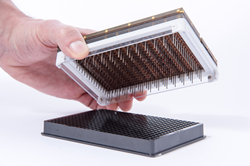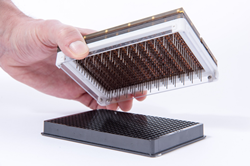
Today, organ-on-chip platforms comprise a growing segment of the market for preclinical drug development and toxicity screening. Pictured is Draper’s PREDICT-96. Credit: Draper
“Biopharma companies in the process of critically evaluating and selecting organ-on-a-chip for targeted therapeutics development are discovering the benefits of platforms that can reveal the effects of toxic compounds and therapies at the tissue-model and even cellular level,” Tim Petrie of Draper.
CAMBRIDGE, Mass. (PRWEB)
March 29, 2022
Draper, a leading provider of organ-on-a-chip and bioprocessing systems, today announced a roadmap for its organ-on-a-chip technology that addresses the growing focus on targeted and advanced therapeutics within drug development. These new human organ models and data acquisition and analysis tools enable the technology to be used within stages of the drug discovery and development process that can evaluate drug toxicity, measure efficacy in disease states and test therapies.
Today, organ-on-chip platforms comprise a growing segment of the market for preclinical drug development and toxicity screening. Most systems are configured as laboratory research tools. However, operation in advanced environments, such as a BSL-3 lab, requires an instrumented well plate designed to fit pharmaceutical industry standard tools. These pharmaceutical industry challenges highlight the need for a more integrated approach to drug discovery than many organ-on-a-chip platforms can provide.
“A proliferation of human tissue models and advances in data science and analytics has spurred the adoption of several transformative approaches to drug development,” Tim Petrie, head of Strategy and Business Development, Pharmaceutical R&D Technologies at Draper, says. “Biopharma companies in the process of critically evaluating and selecting organ-on-a-chip for targeted therapeutics development are discovering the benefits of platforms that can reveal the effects of toxic compounds and therapies at the tissue-model and even cellular level.”
-
New Cell Sources. Cell lines are one of the key tools for studying the effects of toxic compounds and drugs on cells, but they are not representative of patient diversity. The emergence of new cell sources, including primary cells taken directly from human patients, is allowing researchers to develop targeted therapies. Draper’s family of organ-on-a-chip tissue models can accommodate the variety of cell sources researchers use today, whether those are immortalized cell lines, primary human cells or stem cell-derived tissue. - Omics. Omics is a rapidly evolving, multi disciplinary and emerging field that encompasses powerful data acquisition and analysis tools that are rapidly transforming understanding of disease, and making a significant impact on medicine. Organ-on-a-chip can support omics and its various iterations—among them genomics, epigenomics, transcriptomics, proteomics and metabolomics—but only if sufficient and accurate real-time data are collected. PREDICT-96 by Draper is a microenvironment in a high-throughput format that can sustain human microtissue organ models for several weeks and in some cases months of automated testing, robust imaging and -omics assays. Development of various -omics, leading with single-cell transcriptomics, is underway at Draper.
- Drug Development. Developing new drugs requires organ-specific tissue models that function in vitro as they would in specific human organs in vivo. Novel drug discovery efforts suffer from increasing costs and low probability of clinical trial success, largely due to a lack of predictive preclinical in vitro models and reliance on animal testing that often fails to accurately capture human response. Draper has developed offerings to aid therapy development studies using organ models for gum, kidney, liver, vascular, lung, tumor and, soon, gut and neural tissue.
- Multi-Organ Crosstalk. Organ-on-a-chip platforms face a major challenge: single organs can’t replicate the body’s multi-organ environment. Drug toxicity, and often efficacy, can be a consequence of a series of events involving multiple organs. Failure to account for these interactions, or crosstalk, between organs deprives the drug development pipeline of potentially safe and effective therapies and contributes to the high failure rate in drug trials. Draper continues to advance its multi-organ-on-a-chip platforms, which offer precise, robust, practical and reliable approaches that enable crosstalk between multiple organ models.
Draper will introduce new organ models and published research throughout the year. Information about PREDICT-96, including customer deployments, is available at Draper.com.
Draper
At Draper, we believe exciting things happen when new capabilities are imagined and created. Whether formulating a concept and developing each component to achieve a field-ready prototype or combining existing technologies in new ways, Draper engineers apply multidisciplinary approaches that deliver new capabilities to customers. As a nonprofit engineering innovation company, Draper focuses on the design, development and deployment of advanced technological solutions for the world’s most challenging and important problems. We provide engineering solutions directly to government, industry and academia; work on teams as prime contractor or subcontractor; and participate as a collaborator in consortia. We provide unbiased assessments of technology or systems designed or recommended by other organizations—custom designed, as well as commercial-off-the-shelf. Visit Draper at http://www.draper.com.
Share article on social media or email:

